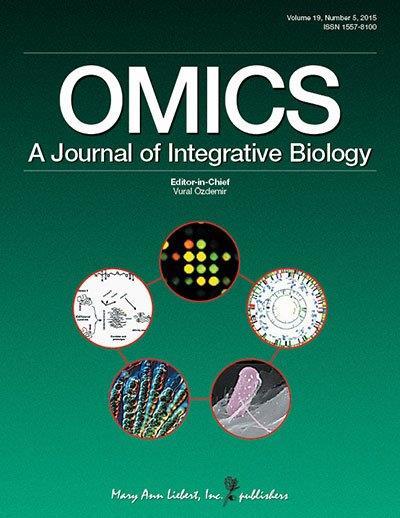Analysis of fluid that bathes the human eye identifies 386 new proteins as biomarker candidates

OMICS: A Journal of Integrative Biology is an authoritative peer-reviewed journal published monthly online, which covers genomics, transcriptomics, proteomics, and metabolomics innovations and omics systems diagnostics for integrative medicine. The Journal explores advances in the era of post-genomic biology and medicine and focuses on the integration of OMICS, data analyses and modeling, and applications of high-throughput approaches to study biological problems. Social, ethical, and public policy aspects of the large-scale biology and 21st century data-enabled sciences are also considered. Complete tables of content and a sample issue may be viewed on the OMICS: A Journal of Integrative Biology website. Credit: ©Mary Ann Liebert, Inc., publishers
These proteins could have a role in disease processes affecting the eye and serve as valuable biomarkers for the development of diagnostics and drug candidates to improve visual health, as discussed in the article “Proteomics of Human Aqueous Humor,” published in OMICS:
A Journal of Integrative Biology, the peer-reviewed interdisciplinary journal published by Mary Ann Liebert, Inc., publishers. The article is available free on the OMICS website until June 26, 2015.
A team of researchers from the United States and India, led by Akhilesh Pandey, MD, PhD, Johns Hopkins University School of Medicine (Baltimore, MD) and Krishna Murthy, DO, MRCOphth (Lon) Institute of Bioinformatics (Bangalore, India), used high-resolution mass spectrometry to analyze and identify the proteins isolated from aqueous humor samples collected from 250 individuals.
More than a third of the proteins were located outside of cells, in the extracellular matrix, and are involved in cell communication and signal transduction. Others have roles in cell growth, differentiation, and proliferation.
Among the proteins unique to this study are growth factors, immunomodulators, and proteins that regulate blood vessel formation. Other enzymes have a role in metabolism and the energy needs of ocular components such as the lens and cornea. For example, sorbitol dehydrogenase, one of the 386 novel proteins identified in the aqueous humor, plays an important role in the metabolism of glucose in the lens.
“Aqueous humor is central to healthy ocular function, yet we do not know enough about its role in ocular physiology and pathology,” says OMICS Editor-in-Chief Vural Özdemir, MD, PhD, DABCP. “The study by Pandey and colleagues shows the enormous potential of proteomics biotechnologies in uncovering novel proteins as biomarker candidates for personalized medicine in ophthalmology.
Because visual disorders represent one of the largest health care expenditures in the United States, costing $139 billion per year, this work is notable for advancing omics systems science applications for visual health.”
###
About the Journal
OMICS: A Journal of Integrative Biology is an authoritative peer-reviewed journal published monthly online, which covers genomics, transcriptomics, proteomics, and metabolomics innovations and omics systems diagnostics for integrative medicine. The Journal explores advances in the era of post-genomic biology and medicine and focuses on the integration of OMICS, data analyses and modeling, and applications of high-throughput approaches to study biological problems. Social, ethical, and public policy aspects of the large-scale biology and 21st century data-enabled sciences are also considered. Complete tables of content and a sample issue may be viewed on the OMICS: A Journal of Integrative Biology website.
About the Publisher
Mary Ann Liebert, Inc., publishers is a privately held, fully integrated media company known for establishing authoritative peer-reviewed journals in many areas of science and biomedical research, including Journal of Computational Biology, ASSAY and Drug Development Technologies, and Zebrafish. Its biotechnology trade magazine, Genetic Engineering & Biotechnology News (GEN), was the first in its field and is today the industry's most widely read publication worldwide. A complete list of the firm's 80 journals, books, and newsmagazines is available on the Mary Ann Liebert, Inc., publishers website.
Media Contact
All latest news from the category: Life Sciences and Chemistry
Articles and reports from the Life Sciences and chemistry area deal with applied and basic research into modern biology, chemistry and human medicine.
Valuable information can be found on a range of life sciences fields including bacteriology, biochemistry, bionics, bioinformatics, biophysics, biotechnology, genetics, geobotany, human biology, marine biology, microbiology, molecular biology, cellular biology, zoology, bioinorganic chemistry, microchemistry and environmental chemistry.
Newest articles

NASA: Mystery of life’s handedness deepens
The mystery of why life uses molecules with specific orientations has deepened with a NASA-funded discovery that RNA — a key molecule thought to have potentially held the instructions for…

What are the effects of historic lithium mining on water quality?
Study reveals low levels of common contaminants but high levels of other elements in waters associated with an abandoned lithium mine. Lithium ore and mining waste from a historic lithium…

Quantum-inspired design boosts efficiency of heat-to-electricity conversion
Rice engineers take unconventional route to improving thermophotovoltaic systems. Researchers at Rice University have found a new way to improve a key element of thermophotovoltaic (TPV) systems, which convert heat…



